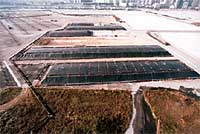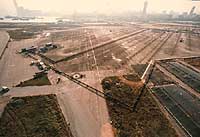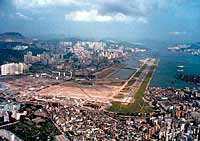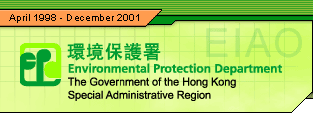|
Content
> Preserving Hong Kong's Natural
Heritage... > Protecting
the Environment for All > Kai
Tak Airport North Apron Decontamination > 1,800
Mega Watt Extension... > West
Rail > International Theme
Park... > Removal of Sediment
in Cheung Sha Wan Fish Culture Zone > Cyberport
Development at Telegraph Bay > Felling
of Five Chimneys at Tsing Yi Power Station > KCR
East Rail Extension > East
Rail Extension
Kai
Tak Airport North Apron Decontamination
Project
Description
|

Biopiles for the treatment of contaminated soil.

Air Sparging and Soil Vapour Extraction in-situ treatment
for contaminated soil.

Kai Tak Airport before decommissioning.
|
With the
new Hong Kong International Airport commissioned at Chek Lap
Kok in July 1998, the disused Kai Tak Airport, an area of
about 160 hectares, would be redeveloped as housing flats,
offices, parks and community facilities for about 115,000
residents. Three hotspots in the Kai Tak Airport North Apron,
totaling about 11 hectares, were found to be contaminated
by jet fuel leakage and had to be cleaned up before redevelopment.
The scale of this decontamination work was the largest of
its kind ever undertaken in Hong Kong.
An Environmental
Permit was issued on 23 September 1998 for this project, which
was started on 26 October 1998. Key activities included decontamination
of the airport site, demolition of buildings and site preparation.
The project would be completed in 2001.
Mitigation Measures and Outcomes
-
Soil Vapour Extraction and Air Sparging (SVE/AS) method
was adopted to treat contaminated soil in-situ to avoid
large-scale excavation and the associated escape of vaporized
contaminants into the atmosphere.
-
Heavily contaminated soil was excavated and treated in "biopiles",
which were piles of soil lined with impervious plastic sheets
on top and bottom to allow biodegradation of the contaminants
while avoiding the escape of vaporized pollutants as well
as containing any leachate runoff.
-
The SVE/AS and biopile systems were connected to a catalytic
incinerator by piping network to burn off any pollutants
in the extracted soil vapour.
-
Proper soil decontamination using these two methods protected
about 700,000 people, including workers and nearby residents,
from any excessive air pollutants and noise impacts associated
with other cleanup methods that employ large-scale excavation.
-
Good housekeeping measures were adopted on site to include:
- Scheduling
excavation work to avoid the rainy season in order to
reduce the potential of generating contaminated surface
runoff.
- Using
quieter plants to reduce construction noise impact.
- Watering
to suppress dust during the demolition stage.
- Collecting
all waste, including chemical wastes and oil, by licensed
chemical waste contractors.
|


